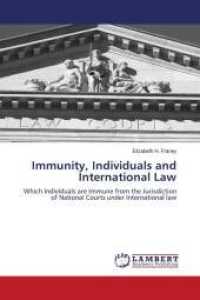Full Description
This comprehensive manual provides a user-oriented overview of U.S. Census data and demographic methods for redistricting applications. It addresses current issues and concerns accompanying the creation, adjustment, and evaluation of election districts and plans that incorporate them using 2020 Federal Census data. It meets the needs of local governments, citizen redistricting commissions, parties to litigation, and practitioners using Census data for political redistricting. The book provides many examples of technical problems that analysts will encounter when applying these data, supplemented by extensive case studies illustrating these technical issues and how they can be addressed. The book is a source to consult for insight, background, and concrete examples of specific issues and concerns and how to address them. As such this comprehensive reference manual is a "must have" for applied demographers, data scientists, statisticians, citizen redistricting commissions, parties to litigation, practitioners, and any analyst or organization engaged in political redistricting using US decennial census data.
Prepublication quotes:
"As a litigator who advises local governments on redistricting matters, this book is an essential resource." John A. Safarli, Partner, Floyd, Pflueger & Ringer, P.S., Seattle, WA
"A valuable primer for those who will participate in redistricting. Provides those new to the highly-charged work of drawing districts an understanding of what is at stake, what options exist and the pitfalls to avoid." Professor Charles S. Bullock, III, University of Georgia (author of Redistricting: The Most Political Activity in America)
"A meticulously researched, well-structured and informative foray into the nuts and bolts of the redistricting process. . .Will aid the bench and bar, public officials, and those elected and appointed citizens who are entrusted with the heavy responsibilities of redistricting from start to finish.
Lives up to its name as a pragmatic guide for those involved in the redistricting process, be they demographic experts, statistical analysts, election law attorneys, litigants, or citizens involved in redistricting commissions.
A resource for teaching election law and for defending governmental entities ensnared in the redistricting process.
A must for anyone engaged in political redistricting based on the 2020 U.S. Census data."
Benjamin E. Griffith, Adjunct Professor of Election Law, University of Mississippi, Robert C. Khayat School of Law, and Principal in Griffith Law Firm, Oxford, Mississippi. (Editor and Author of America Votes! Challenges to Modern Election Law and Voting Rights, ABA Section of State & Local Government Law, 4th Ed.,December 2019)
Contents
Chapter 1: Introduction & Overview.- Chapter 2: Background, Context, and Key Issues.- Chapter 3: Using This Reference Manual.- Part I: DATA AND METHODS.- Chapter 4: Overview of Data Used in Redistricting.- Chapter 5: Building a Redistricting Database.- Chapter 6: Special Purpose Demographic Accounting Models.- Part II: PROFILING LOCAL DEMOGRAPHIC CONTEXTS.- Chapter 7: characterizing and illustrating local contexts.- Chapter 8: Group's intrinsic voting strength.- Chapter 9: Techniques for contrasting the spatial distributions.- Chapter 10: Senate Factor 5 "Lingering effects of discrimination".- Part III: EVALUATING AND COMPARING PLANS.- Chapter 11: Legal considerations.- Chapter 12: Specific concerns in comparing statewide redistricting plans.- Part IV: CASE STUDIES.- Chapter 13: Overview of part IV.- Chapter 14: Integrating Administrative, Political, and Statistical Geography.- Chapter 15: Disparities between Total and Eligible Voter Populations.- Chapter 16: Distinguishing "False Positives" Among Majority-minority Election Districts in Statewide Congressional Redistricting.- Chapter 17: Accounting for Postcensal Population Change.- Chapter 18: Accounting for Prisoner Populations.- Chapter 19: Balancing Representational & Electoral Equality.- Chapter 20: Balancing traditional redistricting criteria.- Chapter 21: Evaluating Minority Voting Strength in Spatially Diverse Contexts.- Chapter 22: Discerning Statistical Imprints of Intent.- Chapter 23: Foreseeing Hispanics' Potential Future Voting Strength.- Chapter 24: Senate Factor 5 Evaluation.- Chapter 25: Characterizing Local Demographic Contexts.
-

- 電子書籍
- 火の鳥 3







